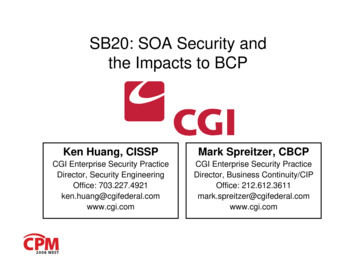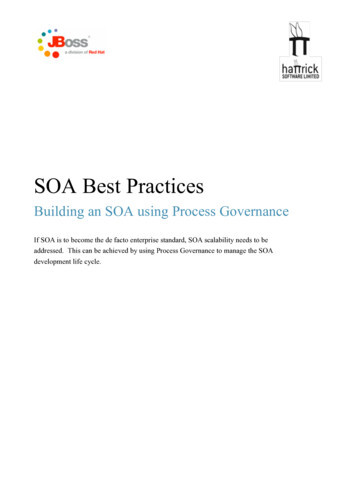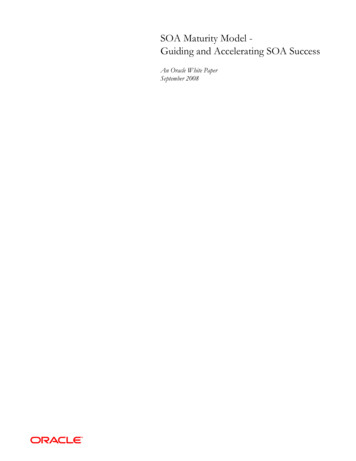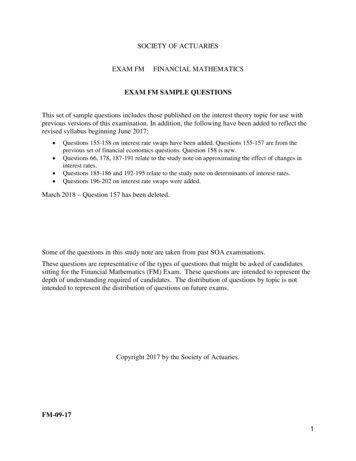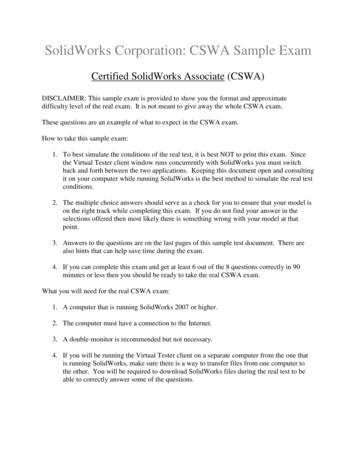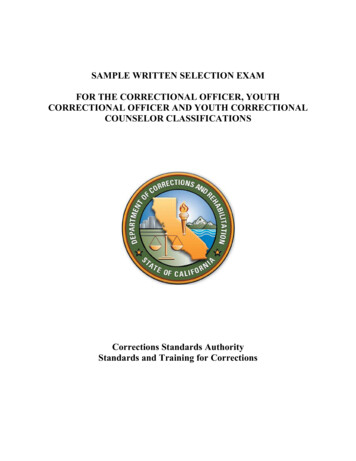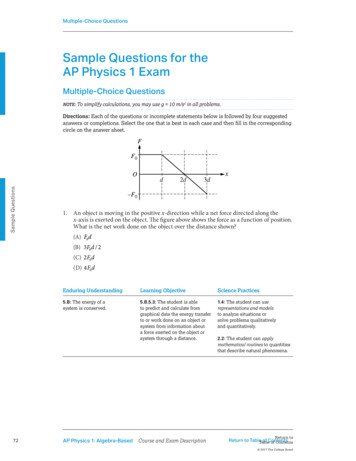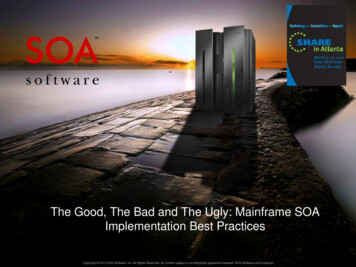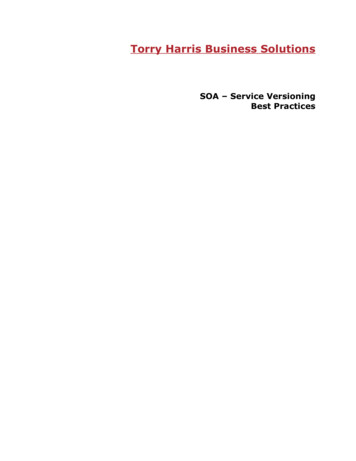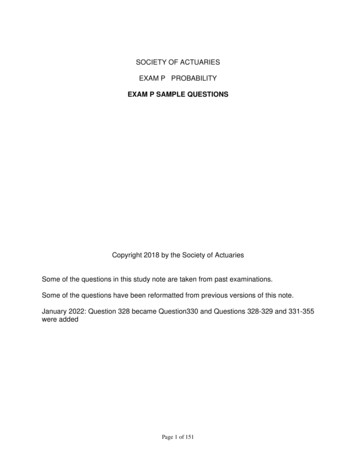
Transcription
SOCIETY OF ACTUARIESEXAM P PROBABILITYEXAM P SAMPLE QUESTIONSCopyright 2018 by the Society of ActuariesSome of the questions in this study note are taken from past examinations.Some of the questions have been reformatted from previous versions of this note.January 2022: Question 328 became Question330 and Questions 328-329 and 331-355were addedPage 1 of 151
1.A survey of a group’s viewing habits over the last year revealed the 8% watched gymnastics29% watched baseball19% watched soccer14% watched gymnastics and baseball12% watched baseball and soccer10% watched gymnastics and soccer8% watched all three sports.Calculate the percentage of the group that watched none of the three sportsduring the last year.(A)(B)(C)(D)(E)2.24%36%41%52%60%The probability that a visit to a primary care physician’s (PCP) office results in neitherlab work nor referral to a specialist is 35%. Of those coming to a PCP’s office, 30% arereferred to specialists and 40% require lab work.Calculate the probability that a visit to a PCP’s office results in both lab work and referralto a 7 and P[ A B′] 0.9 .You are given P[ A B] Calculate P[A].(A)(B)(C)(D)(E)0.20.30.40.60.8Page 2 of 151
4.An urn contains 10 balls: 4 red and 6 blue. A second urn contains 16 red balls and anunknown number of blue balls. A single ball is drawn from each urn. The probabilitythat both balls are the same color is 0.44.Calculate the number of blue balls in the second urn.(A)(B)(C)(D)(E)5.420244464An auto insurance company has 10,000 policyholders. Each policyholder is classified as(i)(ii)(iii)young or old;male or female; andmarried or single.Of these policyholders, 3000 are young, 4600 are male, and 7000 are married. Thepolicyholders can also be classified as 1320 young males, 3010 married males, and 1400young married persons. Finally, 600 of the policyholders are young married males.Calculate the number of the company’s policyholders who are young, female, and single.(A)(B)(C)(D)(E)6.280423486880896A public health researcher examines the medical records of a group of 937 men who diedin 1999 and discovers that 210 of the men died from causes related to heart disease.Moreover, 312 of the 937 men had at least one parent who suffered from heart disease,and, of these 312 men, 102 died from causes related to heart disease.Calculate the probability that a man randomly selected from this group died of causesrelated to heart disease, given that neither of his parents suffered from heart ge 3 of 151
7.An insurance company estimates that 40% of policyholders who have only an auto policywill renew next year and 60% of policyholders who have only a homeowners policy willrenew next year. The company estimates that 80% of policyholders who have both anauto policy and a homeowners policy will renew at least one of those policies next year.Company records show that 65% of policyholders have an auto policy, 50% ofpolicyholders have a homeowners policy, and 15% of policyholders have both an autopolicy and a homeowners policy.Using the company’s estimates, calculate the percentage of policyholders that will renewat least one policy next year.(A)(B)(C)(D)(E)8.20%29%41%53%70%Among a large group of patients recovering from shoulder injuries, it is found that 22%visit both a physical therapist and a chiropractor, whereas 12% visit neither of these. Theprobability that a patient visits a chiropractor exceeds by 0.14 the probability that apatient visits a physical therapist.Calculate the probability that a randomly chosen member of this group visits a .62Page 4 of 151
9.An insurance company examines its pool of auto insurance customers and gathers thefollowing information:(i)(ii)(iii)(iv)All customers insure at least one car.70% of the customers insure more than one car.20% of the customers insure a sports car.Of those customers who insure more than one car, 15% insure a sports car.Calculate the probability that a randomly selected customer insures exactly one car andthat car is not a sports car.(A)(B)(C)(D)(E)0.130.210.240.250.3010.Question duplicates Question 9 and has been deleted.11.An actuary studying the insurance preferences of automobile owners makes the followingconclusions:(i)An automobile owner is twice as likely to purchase collision coverage asdisability coverage.(ii)The event that an automobile owner purchases collision coverage isindependent of the event that he or she purchases disability coverage.(iii) The probability that an automobile owner purchases both collision anddisability coverages is 0.15.Calculate the probability that an automobile owner purchases neither collision nordisability coverage.(A)(B)(C)(D)(E)0.180.330.480.670.82Page 5 of 151
12.A doctor is studying the relationship between blood pressure and heartbeat abnormalitiesin her patients. She tests a random sample of her patients and notes their blood pressures(high, low, or normal) and their heartbeats (regular or irregular). She finds that:(i)(ii)(iii)(iv)(v)14% have high blood pressure.22% have low blood pressure.15% have an irregular heartbeat.Of those with an irregular heartbeat, one-third have high blood pressure.Of those with normal blood pressure, one-eighth have an irregularheartbeat.Calculate the portion of the patients selected who have a regular heartbeat and low bloodpressure.(A)(B)(C)(D)(E)13.2%5%8%9%20%An actuary is studying the prevalence of three health risk factors, denoted by A, B, and C,within a population of women. For each of the three factors, the probability is 0.1 that awoman in the population has only this risk factor (and no others). For any two of thethree factors, the probability is 0.12 that she has exactly these two risk factors (but not theother). The probability that a woman has all three risk factors, given that she has A andB, is 1/3.Calculate the probability that a woman has none of the three risk factors, given that shedoes not have risk factor A.(A)(B)(C)(D)(E)0.2800.3110.4670.4840.700Page 6 of 151
14.In modeling the number of claims filed by an individual under an automobile policyduring a three-year period, an actuary makes the simplifying assumption that for allintegers n ³ 0, p (n 1) 0.2 p (n) where p (n) represents the probability that thepolicyholder files n claims during the period.Under this assumption, calculate the probability that a policyholder files more than oneclaim during the period.15.(A)0.04(B)0.16(C)0.20(D)0.80(E)0.96An insurer offers a health plan to the employees of a large company. As part of this plan,the individual employees may choose exactly two of the supplementary coverages A, B,and C, or they may choose no supplementary coverage. The proportions of thecompany’s employees that choose coverages A, B, and C are 1/4, 1/3, and 5/12respectively.Calculate the probability that a randomly chosen employee will choose no 97/1447/9An insurance company determines that N, the number of claims received in a week, is a1]random variable with P[ N n where n 0 . The company also determines that2n 1the number of claims received in a given week is independent of the number of claimsreceived in any other week.Calculate the probability that exactly seven claims will be received during a giventwo-week period.(A)(B)(C)(D)(E)1/2561/1287/5121/641/32Page 7 of 151
17.An insurance company pays hospital claims. The number of claims that includeemergency room or operating room charges is 85% of the total number of claims. Thenumber of claims that do not include emergency room charges is 25% of the total numberof claims. The occurrence of emergency room charges is independent of the occurrenceof operating room charges on hospital claims.Calculate the probability that a claim submitted to the insurance company includesoperating room charges.(A)(B)(C)(D)(E)18.0.100.200.250.400.80Two instruments are used to measure the height, h, of a tower. The error made by theless accurate instrument is normally distributed with mean 0 and standard deviation0.0056h. The error made by the more accurate instrument is normally distributed withmean 0 and standard deviation 0.0044h.The errors from the two instruments are independent of each other.Calculate the probability that the average value of the two measurements is within 0.005hof the height of the tower.(A)(B)(C)(D)(E)0.380.470.680.840.90Page 8 of 151
19.An auto insurance company insures drivers of all ages. An actuary compiled thefollowing statistics on the company’s insured drivers:Age ofDriver16-2021-3031-6566-99Probabilityof Accident0.060.030.020.04Portion of Company’sInsured Drivers0.080.150.490.28A randomly selected driver that the company insures has an accident.Calculate the probability that the driver was age 16-20.(A)(B)(C)(D)(E)20.0.130.160.190.230.40An insurance company issues life insurance policies in three separate categories:standard, preferred, and ultra-preferred. Of the company’s policyholders, 50% arestandard, 40% are preferred, and 10% are ultra-preferred. Each standard policyholderhas probability 0.010 of dying in the next year, each preferred policyholder hasprobability 0.005 of dying in the next year, and each ultra-preferred policyholderhas probability 0.001 of dying in the next year.A policyholder dies in the next year.Calculate the probability that the deceased policyholder was .01410.2817Page 9 of 151
21.Upon arrival at a hospital’s emergency room, patients are categorized according to theircondition as critical, serious, or stable. In the past year:(i)(ii)(iii)(iv)(vi)(vii)10% of the emergency room patients were critical;30% of the emergency room patients were serious;the rest of the emergency room patients were stable;40% of the critical patients died;10% of the serious patients died; and1% of the stable patients died.Given that a patient survived, calculate the probability that the patient was categorized asserious upon arrival.(A)(B)(C)(D)(E)22.0.060.290.300.390.64A health study tracked a group of persons for five years. At the beginning of the study,20% were classified as heavy smokers, 30% as light smokers, and 50% as nonsmokers.Results of the study showed that light smokers were twice as likely as nonsmokers to dieduring the five-year study, but only half as likely as heavy smokers.A randomly selected participant from the study died during the five-year period.Calculate the probability that the participant was a heavy smoker.(A)(B)(C)(D)(E)0.200.250.350.420.57Page 10 of 151
23.An actuary studied the likelihood that different types of drivers would be involved in atleast one collision during any one-year period. The results of the study are:Type ofdriverTeenYoung adultMidlifeSeniorTotalPercentage ofall drivers8%16%45%31%100%Probabilityof at least onecollision0.150.080.040.05Given that a driver has been involved in at least one collision in the past year, calculatethe probability that the driver is a young adult driver.24.(A)0.06(B)0.16(C)0.19(D)0.22(E)0.25The number of injury claims per month is modeled by a random variable N with1, for nonnegative integers, n.(n 1)(n 2)Calculate the probability of at least one claim during a particular month, given that therehave been at most four claims during that month.P[ N n ](A)(B)(C)(D)(E)1/32/51/23/55/6Page 11 of 151
25.A blood test indicates the presence of a particular disease 95% of the time when thedisease is actually present. The same test indicates the presence of the disease 0.5% ofthe time when the disease is not actually present. One percent of the population actuallyhas the disease.Calculate the probability that a person actually has the disease given that the test indicatesthe presence of the 5The probability that a randomly chosen male has a blood circulation problem is 0.25.Males who have a blood circulation problem are twice as likely to be smokers as thosewho do not have a blood circulation problem.Calculate the probability that a male has a blood circulation problem, given that he is asmoker.(A)(B)(C)(D)(E)1/41/32/51/22/3Page 12 of 151
27.A study of automobile accidents produced the following data:Modelyear201420132012OtherProportion ofall vehicles0.160.180.200.46Probability ofinvolvementin an accident0.050.020.030.04An automobile from one of the model years 2014, 2013, and 2012 was involved in anaccident.Calculate the probability that the model year of this automobile is 2014.(A)(B)(C)(D)(E)28.0.220.300.330.450.50A hospital receives 1/5 of its flu vaccine shipments from Company X and the remainderof its shipments from other companies. Each shipment contains a very large number ofvaccine vials.For Company X’s shipments, 10% of the vials are ineffective. For every other company,2% of the vials are ineffective. The hospital tests 30 randomly selected vials from ashipment and finds that one vial is ineffective.Calculate the probability that this shipment came from Company X.(A)(B)(C)(D)(E)0.100.140.370.630.86Page 13 of 151
29.The number of days that elapse between the beginning of a calendar year and the momenta high-risk driver is involved in an accident is exponentially distributed. An insurancecompany expects that 30% of high-risk drivers will be involved in an accident during thefirst 50 days of a calendar year.Calculate the portion of high-risk drivers are expected to be involved in an accidentduring the first 80 days of a calendar year.30.(A)0.15(B)0.34(C)0.43(D)0.57(E)0.66An actuary has discovered that policyholders are three times as likely to file two claimsas to file four claims.The number of claims filed has a Poisson distribution.Calculate the variance of the number of claims filed.13(A)(B)(C)(D)(E)31.1224A company establishes a fund of 120 from which it wants to pay an amount, C, to any ofits 20 employees who achieve a high performance level during the coming year. Eachemployee has a 2% chance of achieving a high performance level during the comingyear. The events of different employees achieving a high performance level during thecoming year are mutually independent.Calculate the maximum value of C for which the probability is less than 1% that the fundwill be inadequate to cover all payments for high performance.(A)(B)(C)(D)(E)24304060120Page 14 of 151
32.A large pool of adults earning their first driver’s license includes 50% low-risk drivers,30% moderate-risk drivers, and 20% high-risk drivers. Because these drivers have noprior driving record, an insurance company considers each driver to be randomly selectedfrom the pool.This month, the insurance company writes four new policies for adults earning their firstdriver’s license.Calculate the probability that these four will contain at least two more high-risk driversthan low-risk 3The loss due to a fire in a commercial building is modeled by a random variable X withdensity function 0.005(20 x), 0 x 20f ( x) otherwise. 0,Given that a fire loss exceeds 8, calculate the probability that it exceeds 16.(A)(B)(C)(D)(E)34.1/251/91/81/33/7The lifetime of a machine part has a continuous distribution on the interval (0, 40) withprobability density function f(x), where f(x) is proportional to (10 x) 2 on the interval.Calculate the probability that the lifetime of the machine part is less than 6.(A)(B)(C)(D)(E)0.040.150.470.530.94Page 15 of 151
35.This question duplicates Question 34 and has been deleted.36.A group insurance policy covers the medical claims of the employees of a smallcompany. The value, V, of the claims made in one year is described byV 100,000Ywhere Y is a random variable with density function k (1 y ) 4 , 0 y 1f ( y) otherwise 0,where k is a constant.Calculate the conditional probability that V exceeds 40,000, given that V exceeds 10,000.37.(A)0.08(B)0.13(C)0.17(D)0.20(E)0.51The lifetime of a printer costing 200 is exponentially distributed with mean 2 years. Themanufacturer agrees to pay a full refund to a buyer if the printer fails during the first yearfollowing its purchase, a one-half refund if it fails during the second year, and no refundfor failure after the second year.Calculate the expected total amount of refunds from the sale of 100 2Page 16 of 151
38.An insurance company insures a large number of homes. The insured value, X, of arandomly selected home is assumed to follow a distribution with density function 3 x 4 , x 1f ( x) otherwise. 0,Given that a randomly selected home is insured for at least 1.5, calculate the probabilitythat it is insured for less than 2.39.(A)0.578(B)0.684(C)0.704(D)0.829(E)0.875A company prices its hurricane insurance using the following assumptions:(i)(ii)(iii)In any calendar year, there can be at most one hurricane.In any calendar year, the probability of a hurricane is 0.05.The numbers of hurricanes in different calendar years are mutuallyindependent.Using the company’s assumptions, calculate the probability that there are fewerthan 3 hurricanes in a 20-year period.(A)(B)(C)(D)(E)0.060.190.380.620.92Page 17 of 151
40.An insurance policy pays for a random loss X subject to a deductible of C, where0 C 1 . The loss amount is modeled as a continuous random variable with densityfunction 2 x, 0 x 1f ( x) 0, otherwise.Given a random loss X, the probability that the insurance payment is less than 0.5 is equalto 0.64.Calculate C.(A)(B)(C)(D)(E)41.0.10.30.40.60.8A study is being conducted in which the health of two independent groups of tenpolicyholders is being monitored over a one-year period of time. Individual participantsin the study drop out before the end of the study with probability 0.2 (independently ofthe other participants).Calculate the probability that at least nine participants complete the study in one of thetwo groups, but not in both e 18 of 151
42.For Company A there is a 60% chance that no claim is made during the coming year. Ifone or more claims are made, the total claim amount is normally distributed with mean10,000 and standard deviation 2,000.For Company B there is a 70% chance that no claim is made during the coming year. Ifone or more claims are made, the total claim amount is normally distributed with mean9,000 and standard deviation 2,000.The total claim amounts of the two companies are independent.Calculate the probability that, in the coming year, Company B’s total claim amount willexceed Company A’s total claim A company takes out an insurance policy to cover accidents that occur at itsmanufacturing plant. The probability that one or more accidents will occur during anygiven month is 0.60. The numbers of accidents that occur in different months aremutually independent.Calculate the probability that there will be at least four months in which no accidentsoccur before the fourth month in which at least one accident occurs.(A)(B)(C)(D)(E)0.010.120.230.290.41Page 19 of 151
44.An insurance policy pays 100 per day for up to three days of hospitalization and 50 perday for each day of hospitalization thereafter.The number of days of hospitalization, X, is a discrete random variable with probabilityfunction 6 k, k 1, 2,3, 4,5 P[ X k ] 15 0,otherwise.Determine the expected payment for hospitalization under this policy.(A)(B)(C)(D)(E)45.123210220270367Let X be a continuous random variable with density function x , 2 x 4f ( x) 10 0,otherwise.Calculate the expected value of X.(A)(B)(C)(D)(E)1/53/5128/1512/5Page 20 of 151
46.A device that continuously measures and records seismic activity is placed in a remoteregion. The time, T, to failure of this device is exponentially distributed with mean 3years. Since the device will not be monitored during its first two years of service, thetime to discovery of its failure is X max(T, 2).Calculate E(X).(A)(B)(C)(D)(E)47.12 e 632 2e 2/3 5e 4/332 3e 2/35A piece of equipment is being insured against early failure. The time from purchase untilfailure of the equipment is exponentially distributed with mean 10 years. The insurancewill pay an amount x if the equipment fails during the first year, and it will pay 0.5x iffailure occurs during the second or third year. If failure occurs after the first three years,no payment will be made.Calculate x such that the expected payment made under this insurance is 1000.(A)(B)(C)(D)(E)48.38584449538256447235An insurance policy on an electrical device pays a benefit of 4000 if the device failsduring the first year. The amount of the benefit decreases by 1000 each successive yearuntil it reaches 0. If the device has not failed by the beginning of any given year, theprobability of failure during that year is 0.4.Calculate the expected benefit under this policy.(A)(B)(C)(D)(E)22342400250026672694Page 21 of 151
49.This question duplicates Question 44 and has been deleted50.A company buys a policy to insure its revenue in the event of major snowstorms that shutdown business. The policy pays nothing for the first such snowstorm of the year and10,000 for each one thereafter, until the end of the year. The number of majorsnowstorms per year that shut down business is assumed to have a Poisson distributionwith mean 1.5.Calculate the expected amount paid to the company under this policy during a (E)10,578A manufacturer’s annual losses follow a distribution with density function 2.5(0.6) 2.5, x 0.6 f ( x) x 3.5 0,otherwise. To cover its losses, the manufacturer purchases an insurance policy with an annualdeductible of 2.Calculate the mean of the manufacturer’s annual losses not paid by the insurance policy.(A)(B)(C)(D)(E)0.840.880.930.951.00Page 22 of 151
52.An insurance company sells a one-year automobile policy with a deductible of 2. Theprobability that the insured will incur a loss is 0.05. If there is a loss, the probability of aloss of amount N is K/N, for N 1, . . . , 5 and K a constant. These are the only possibleloss amounts and no more than one loss can occur.Calculate the expected payment for this An insurance policy reimburses a loss up to a benefit limit of 10. The policyholder’sloss, Y, follows a distribution with density function: 2 y 3 , y 1f ( y) otherwise. 0,Calculate the expected value of the benefit paid under the insurance policy.54.(A)1.0(B)1.3(C)1.8(D)1.9(E)2.0An auto insurance company insures an automobile worth 15,000 for one year under apolicy with a 1,000 deductible. During the policy year there is a 0.04 chance of partialdamage to the car and a 0.02 chance of a total loss of the car. If there is partial damage tothe car, the amount X of damage (in thousands) follows a distribution with densityfunction 0.5003e x /2 , 0 x 15f ( x) otherwise. 0,Calculate the expected claim payment.(A)(B)(C)(D)(E)55.320328352380540An insurance company’s monthly claims are modeled by a continuous, positive randomvariable X, whose probability density function is proportional to (1 x)- 4, for 0 x .Calculate the company’s expected monthly claims.Page 23 of 151
(A)(B)(C)(D)(E)56.1/61/31/213An insurance policy is written to cover a loss, X, where X has a uniform distribution on[0, 1000]. The policy has a deductible, d, and the expected payment under the policy is25% of what it would be with no deductible.Calculate d.(A)(B)(C)(D)(E)57.250375500625750An actuary determines that the claim size for a certain class of accidents is a randomvariable, X, with moment generating functionM X (t ) 1.(1 2500t ) 4Calculate the standard deviation of the claim size for this class of 80Page 24 of 151
58.A company insures homes in three cities, J, K, and L. Since sufficient distance separatesthe cities, it is reasonable to assume that the losses occurring in these cities are mutuallyindependent.The moment generating functions for the loss distributions of the cities are:M J (t ) (1 2t ) 3 , M K (t ) (1 2t ) 2.5 , M L (t ) (1 2t ) 4.5 .Let X represent the combined losses from the three cities.3Calculate E ( X ) .59.(A)1,320(B)2,082(C)5,760(D)8,000(E)10,560An insurer's annual weather-related loss, X, is a random variable with density function 2.5(200) 2.5, x 200 f ( x) x 3.5 0,otherwise. Calculate the difference between the 30th and 70th percentiles of X.(A)(B)(C)(D)(E)3593124231298Page 25 of 151
60.A recent study indicates that the annual cost of maintaining and repairing a car in a townin Ontario averages 200 with a variance of 260.A tax of 20% is introduced on all items associated with the maintenance and repair ofcars (i.e., everything is made 20% more expensive).Calculate the variance of the annual cost of maintaining and repairing a car after the tax isintroduced.61.(A)208(B)260(C)270(D)312(E)374This question duplicates Question 59 and has been deleted62.A random variable X has the cumulative distribution functionx 1 0, 2 x 2x 2, 1 x 2 F ( x) 2 x 2. 1,Calculate the variance of X.(A)(B)(C)(D)(E)7/721/85/364/323/12Page 26 of 151
63.The warranty on a machine specifies that it will be replaced at failure or age 4, whicheveroccurs first. The machine’s age at failure, X, has density function 1/ 5, 0 x 5f ( x) otherwise. 0,Let Y be the age of the machine at the time of replacement.Calculate the variance of Y.(A)(B)(C)(D)(E)64.1.31.41.72.17.5A probability distribution of the claim sizes for an auto insurance policy is given in thetable 600.10700.10800.30Calculate the percentage of claims that are within one standard deviation of the meanclaim size.(A)(B)(C)(D)(E)65.45%55%68%85%100%The owner of an automobile insures it against damage by purchasing an insurance policywith a deductible of 250. In the event that the automobile is damaged, repair costs can bemodeled by a uniform random variable on the interval (0, 1500).Calculate the standard deviation of the insurance payment in the event that theautomobile is damaged.(A)(B)361403Page 27 of 151
66.67.(C)433(D)464(E)521DELETEDA baseball team has scheduled its opening game for April 1. If it rains on April 1, thegame is postponed and will be played on the next day that it does not rain. The teampurchases insurance against rain. The policy will pay 1000 for each day, up to 2 days,that the opening game is postponed.The insurance company determines that the number of consecutive days of rain beginningon April 1 is a Poisson random variable with mean 0.6.Calculate the standard deviation of the amount the insurance company will have to pay.(A)(B)(C)(D)(E)668699775817904Page 28 of 151
68.An insurance policy reimburses dental expense, X, up to a maximum benefit of 250. Theprobability density function for X is: ce 0.004 x , x 0f ( x) otherwise 0,where c is a constant.Calculate the median benefit for this policy.(A)(B)(C)(D)(E)69.161165173182250The time to failure of a component in an electronic device has an exponential distributionwith a median of four hours.Calculate the probability that the component will work without failing for at least fivehours.70.(A)0.07(B)0.29(C)0.38(D)0.42(E)0.57An insurance company sells an auto insurance policy that covers losses incurred by apolicyholder, subject to a deductible of 100. Losses incurred follow an exponentialdistribution with mean 300.Calculate the 95th percentile of losses that exceed the deductible.(A)(B)(C)(D)(E)6007008009001000Page 29 of 151
71.The time, T, that a manufacturing system is out of operation has cumulative distributionfunction 2 2, t 2 1 F (t ) t 0,otherwise. 2The resulting cost to the company is Y T . Let g be the density function for Y.Determine g(y), for y 4.(A)(B)(C)(D)(E)72.4y28y 3/28y316y1024y5An investment account earns an annual interest rate R that follows a uniform distributionon the interval (0.04, 0.08). The value of a 10,000 initial investment in this account afterRone year is given by V 10,000e .Let F be the cumulative distribution function of V.Determine F(v) for values of v that satisfy 0 F (v) 1 .(A)(B)(C)(D)(E)10, 000ev /10,000 10, 408425v /10,00025e 0.04v 10, 40810,833 10, 40825v v 25 ln 0.04 10, 000 Page 30 of 151
73.An actuary models the lifetime of a device using the random variable Y 10X 0.8, whereX is an exponential random variable with mean 1.Let f(y) be the density function for Y.Determine f (y), for y 0.(A)(B)(C)(D)(E)74.10 y 0.8 exp( 8 y 0.2 )8 y 0.2 exp( 10 y 0.8 )8 y 0.2 exp[ (0.1y )1.25 ](0.1y )1.25 exp[ 0.125(0.1y )0.25 ]0.125(0.1y )0.25 exp[ (0.1y )1.25 ]Let T denote the time in minutes for a customer service representative to respond to 10telephone inquiries. T is uniformly distributed on the interval with endpoints 8 minutesand 12 minutes.Let R denote the average rate, in customers per minute, at which the representativeresponds to inquiries, and let f(r) be the density function for R.Determine f(r), for(A)(B)(C)(D)(E)1010 r .12812552r5ln(r )3r 210r252r 23 Page 31 of 151
75.The monthly profit of Company I can be modeled by a continuous random variable withdensity function f. Company II has a monthly profit that is twice that of Company I.Let g be the density function for the distribution of the monthly profit of Company II.Determine g(y) where it is not zero.(A)(B)(C)(D)(E)76. y f 2 y f 2 y 2f 2 2 f ( y)2 f (2 y )12Claim amounts for wind damage to insured homes are mutually independent randomvariables with common density function 3 , x
Page 3 of 151 . 4. An urn contains 10 balls: 4 red and 6 blue. A second urn contains 16 red balls and an unknown number of blue balls. A single ball is drawn from each urn.
